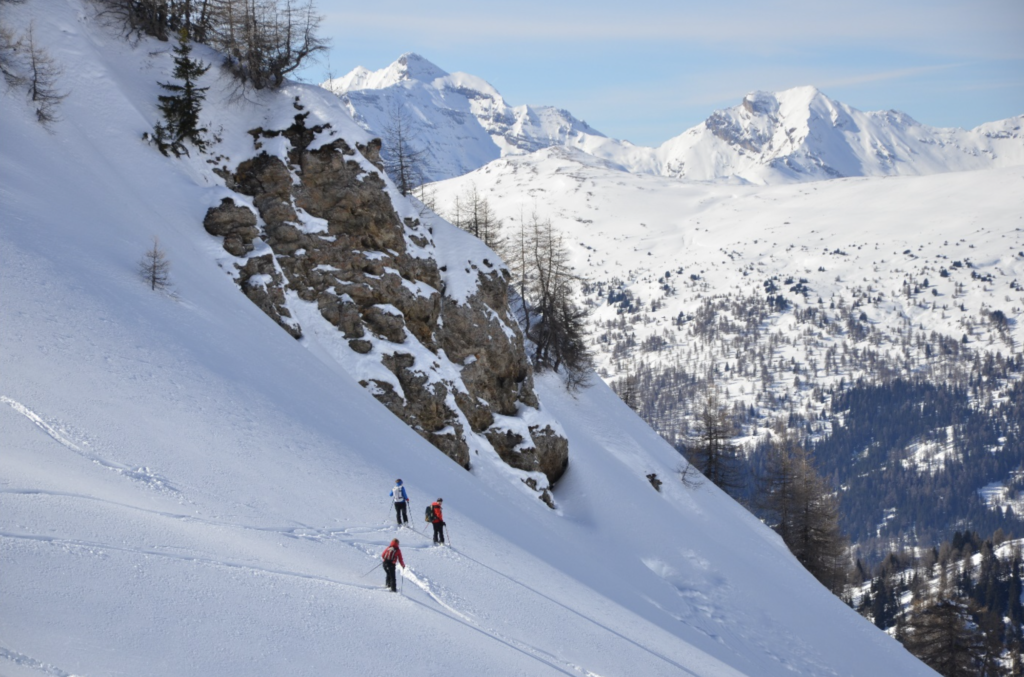By Oliver Tamme, Ingrid Machold and Somaye Latifi (Federal Institute of Agricultural Economics, Rural and Mountain Research (BAB), Vienna)
Mountain areas attract outstanding numbers of tourists. After beaches and islands, they act as the second most demanded outdoor destination for tourism activities. Where agriculture has long been the main source of income and entire areas are characterised by outmigration, tourism has sustainably improved and transformed the working and living conditions of local populations. Based on work being done in Austria, this blog shares insights into how promoting tourism activities in so-called Mountaineering Villages as a means of income diversification beyond traditional sectors can pose as an effective solution in marginalised mountain areas.
Mountain tourism can play a pivotal role for communities by significantly contributing to income and employment. However, the distribution of tourism activities is highly uneven and may threaten sensitive mountain ecosystems and social cohesion in local communities, even leading to economic dependence in some regions.Balancing tourism development with local needs and natural resources can help mitigate negative impacts and ensure the long-term sustainability of a region’s touristic development (Dax and Tamme, 2022). The concept of “Mountaineering Villages” is one such initiative implemented towards sustainable tourism in the mountainous regions of Austria. It presents an alternative pathway for tourism development, especially in less developed regions facing marginalisation and population decline (Dax and Tamme, 2023).
Tourism as a Driver for Revitalising Marginalised Mountain Areas
Tourism is a potential catalyst for the development of marginalised mountain areas. If successful, tourism initiatives generate economic activity in low-population density areas at risk of depopulation by creating new job opportunities and promoting social inclusion (FAO and UNWTO, 2023). Tourism also often prompts improved infrastructure in these areas. Better roads, transportation systems, and communication networks benefit both residents and tourists. By showcasing them to visitors, tourism can also help preserve local traditions, customs, and crafts, potentially leading to the revitalisation of cultural practices and providing economic opportunities for artisans and cultural practitioners. Overall, tourism has been viewed as an opportunity to cope with marginalisation threats and improve the incomes of those living in mountainous regions (Dax and Tamme, 2023).
However, the tourism sector is not equally distributed spatially and is generally concentrated in local hotspots. Valleys and villages far away from popular holiday regions may not benefit from tourism activities the same way less remote regions would (Tamme and Quendler, 2023). On the other hand, “over-tourism” (Peeters et al., 2018) in popular mountain tourism destinations pose significant challenges to the sustainability and authenticity of these regions. High volumes of tourists can strain fragile mountain ecosystems and lead to deforestation, damage to wildlife habitats, soil erosion, disruptions in natural flora and fauna, and pollution.

The Distribution of Tourism Activities in Mountain Areas
The uneven distribution of tourism activities in mountain areas describes the concentration of tourist attractions, infrastructure, and visitor activities in specific areas within mountainous landscapes, which can lead to disparities and imbalances across the region. The European Alps are one of the most-visited mountain chains, but although popular Alpine areas benefit from high tourism activities, others are hardly visited and face marginalisation (Capocchi et al., 2019; Dax and Tamme, 2023). While regions with popular tourist attractions benefit economically from tourism-generated revenues (but must cope with the environmental impacts of tourism activities), areas that are not as frequented miss out on economic opportunities. This leads to disparities in income and employment amongst different parts of mountain regions.
By addressing these imbalances and promoting a more equitable distribution of tourism activities, mountain areas can harness the potential of tourism for economic growth while preserving their natural and cultural heritage. The Alpine Convention, which advocates for a sustainable, territorial development of the Alpine region across all sectors, also argues along these lines. The Tourism Protocol of the Alpine Convention stipulates that there should be a balanced relationship between intensive and extensive forms of tourism in areas attracting high numbers of tourists. To address these disparities and promote sustainable development in mountain regions, the “Mountaineering Villages” initiative, promoted by the Alpine Convention, has become a driving force aimed at shifting perspectives and encouraging tourists to participate in sustainable tourism activities (Dax and Tamme, 2022).
The Mountaineering Villages Initiative
In 2008, the Mountaineering Villages initiative was launched by the Austrian Alpine Association (OeAV). Its main objective at the time was to foster a gentle, nature-oriented form of tourism far from extensive (winter) sports facilities and large-scale hotels, prioritising the preservation of each village’s unique character. Originally conceived as a localised development effort, it aimed to offer alternative growth prospects for communities distant from mass tourism hubs. The initiative targeted outdoor enthusiasts such as mountaineers, climbers, and ski tourers. Over time, it expanded to include other member states of the Alpine Convention (i.e., Germany, Switzerland, Italy, and Slovenia).
Becoming a Mountaineering Village requires compliance with strict criteria, which serves as a pledge of quality for holiday goers. These criteria ensure the preservation of landscapes and environmental standards, distinguishing participatory villages from resource-heavy tourism practices observed in other regions. The Mountaineering Village initiative also includes 123 tourism partner businesses, such as inns, guesthouses, and hotels, which act as a vital connection between the Austrian Alpine Association management in Innsbruck, guests, and local promoters. The initiative’s primary aim is achieving consistent year-round occupancy rates and fostering value and sustainable income through guest accommodations (Tamme and Quendler, 2023).
Challenges and Potentials of the Mountaineering Villages Initiative
Like other initiatives implemented in mountain communities, Mountaineering Villages has faced challenges. From 2020 to 2023, a research project was conducted to analyse and evaluate the initiative (Tamme and Quendler, 2023). It found the establishment of the label “Mountaineering Village” to be a major challenge, as well as continuously raising awareness, emphasising destinations’ unique selling propositions (USP), and promoting destination marketing. This is because the Mountaineering Village initiative operates within a limited tourism niche, primarily targeting Alpine enthusiasts. Supporting the preservation, social infrastructure, and services of Mountaineering Villages (inns, local services, and service providers) is therefore crucial for their success. Mobility, beyond personal motorised transport, poses a further critical factor. To this end, some villages are currently exploring solutions like pickup services and organised carpooling.
The results of the project also highlight the importance of local promoters, acknowledging their role as key contacts and influencers crucial to the initiative’s success. Nevertheless, when municipal representatives directly delegate the initiative to tourism officials, the potential and effectiveness of cross-sectoral collaboration is diminished. This may also have contributed to the fact that the local population is often insufficiently involved in the initiative. Another potential threat is the relationship between the initiative and mountain farmers, as ties with mountain farming are essential for preserving cultural landscapes. Conflicts between landowners, farmers, and hunting leaseholders occur mainly because of the volume of traffic (e.g., over-parking) or the frequent use of Alpine climbs and hiking trails.
The potentials of the Mountaineering Villages initiative include close cooperation with different types of protected areas, enhanced credibility through the label of “Mountaineering Villages,” increased inter-municipal cooperation, and the creation of adapted strategies and innovative ideas (Tamme et al., 2022). Overall, the risk of over-tourism has shown to be minimal due to restrained guest numbers tied to available accommodation infrastructure. Results of the research project’s quantitative survey reveal that the visitors of mountaineering villages notably value nature and landscapes, and associate attributes like closeness to nature, sustainability, authenticity, and hospitality with their stay. Holidaymakers expressed a high level of satisfaction with their stay and assigned better satisfaction values than the average guests in other Austrian destinations (Tamme and Quendler, 2023).
The Mountaineering Villages Initiative as a Model for Developing Sustainable Tourism Pathways in Marginalised Mountain Areas
The Mountaineering Villages initiative has been implemented in Austria for 15 years, whereas other Alpine countries recently adopted similar strategies in their respective contexts. The Mountaineering Village model has been recognised as an approach to sustainable mountain tourism and a model for sustainable tourism pathways, especially in marginalised mountainous regions. Its emphasis on sustainable practices, the preservation of local culture, and responsible tourism aligns well with the needs of such areas. By showcasing a balance between nature-oriented activities and community engagement, Mountaineering Villages can serve as an inspiration for regions to develop tourism in a way that benefits both the environment and local communities (Dax and Tamme, 2022).
While all mountain areas have their unique set of challenges and opportunities, adopting a community-driven, sustainable approach to tourism development similar to that of the Mountaineering Village concept can serve as a valuable guideline for marginalised mountain regions seeking solutions to break periphery traps.
The header image depicts Gesaeuse, Austria (Credits: Stefan Leitner /OeAV)
References
Capocchi, A., Vallone, C., Pierotti, M. and Amaduzzi, A. (2019). Overtourism: A literature reviews to assess implications and future perspectives. Sustainability 11 (12): 1-18. doi:10.3390/su11123303 https://www.mdpi.com/2071-1050/11/12/3303
Dax, T., and Tamme, O. (2022). Sustainable mountain tourism in the Alps: The “Mountaineering Villages” concept, a local model for sustainable mountain tourism in the Alps. Tourism and Rural Space 48(2): 106-126. https://zenodo.org/records/7547113
Dax, T. and Tamme, O. (2023). Attractive landscape features as drivers for sustainable mountain tourism experiences. Tourism and hospitality 4(3): 374-389. doi.org/10.3390/tourhosp4030023 https://www.mdpi.com/2673-5768/4/3/23/review_report
Elmi, M. and Wolff, S. (2021). Mountaineering village for sustainable Alpine tourism. In: R. Rome, L. Russo, F. Parisi, M. Notarianni, S. Manuelli, S. and S. Carvao (Eds.). Mountain tourism toward a more sustainable path, pp.46-48. Rome: FAO and UNWTO. doi.org/10.4060/cb7884en https://www.fao.org/documents/card/en/c/cb7884en
FAO and UNWTO (2023). Understanding and Quantifying Mountain Tourism. Rome: FAO and Madrid: UNWTO. doi.org/10.18111/9789284424023 https://www.e-unwto.org/doi/book/10.18111/9789284424023
Peeters, P., Gössling, S., Klijs, J., Milano, C., Novelli, M., Dijkmans, C., Eijgelaar, E., Hartman, S., Heslinga, J., Isaac, R., Mitas, O., Moretti, S., Nawijn, J., Papp, B. and Postma, A. (2018). Research for TRAN Committee – Overtourism: Impact and Possible Policy Responses. Brussels: European Parliament, Policy Department for Structural and Cohesion Policies. https://www.europarl.europa.eu/RegData/etudes/STUD/2018/629184/IPOL_STU(2018)629184_EN.pdf
Tamme, O, Quendler, E and Dax, T. (2022). Sustainable alpine tourism, where ‘mountaineering villages’ meet the farm. International Workshop on Agritourism, 1 September 2022 (online), University of Vermont. https://bab.gv.at/index.php?option=com_rsfiles&layout=download&path=Publikationen%2FBAB%2FSeminarunterlagen%2F2022%2Fmountaineering_villages_vermont_presentation+dax+tamme.pdf&lang=en&Itemid=413
Tamme, O. and Quendler, E. (2023). Die Bergdörfer. Eine Initiative des Österreichischen Alpenvereins (OEAV) als Umsetzungsprojekt der Alpenkonvention (AK). BAB Report 004. Wien: Bundesanstalt für Agrarwirtschaft und Bergbauernfragen. https://bab.gv.at/index.php?option=com_content&view=article&id=2268:bab-report-004-die-bergsteigerdoerfer&catid=139&lang=de&Itemid=567


